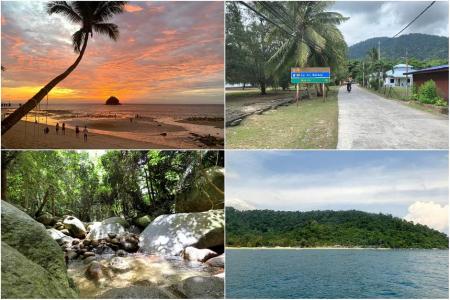More than scuba diving: Tioman’s top 5 land activities
TIOMAN, Malaysia – Before this trip, I had explored more of Tioman underwater than on land.
Like many others, I got my scuba diving certification there, which involved a bumpy bus-and-boat transit after work on a Friday evening, spending all of Saturday out on the water, and rushing back to Singapore on Sunday afternoon.
More than a decade later, the island’s rich marine life and splendid beaches are still its main draw. But I also discover lush tropical forests, and hills that seem to extend into the clouds.
Unlike the rustic, chalet-like accommodation that divers associate with Tioman, properties such as the Berjaya Tioman Resort (tioman.berjayahotel.com), which opened in 1985, have used the downtime during the pandemic to refresh their offerings. It reopened this April after a facelift, in time for Tioman’s peak travel season.
If you are travelling with non-divers or looking to pepper your diving schedule with land activities, here are five ways to explore this idyllic island.
Go village hopping
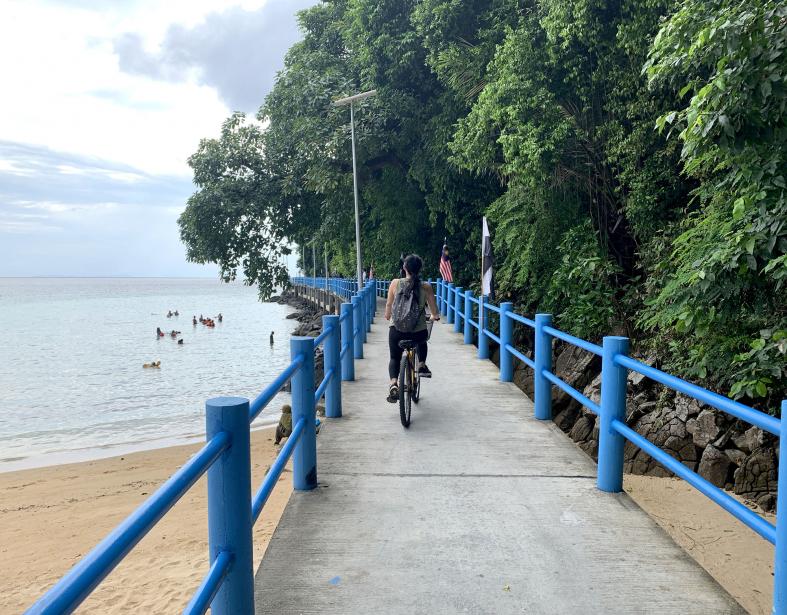
Pulau Tioman, the largest island on Malaysia’s east coast, has a handful of kampungs scattered along its sandy shores, each with a distinct vibe.
My resort is located in Tekek, the administrative centre and largest village in Tioman. Most of the island’s amenities are here, including a tiny airport, the sole bank branch and a duty-free outlet for cheap alcohol.
Just south of Tekek, Paya is more touristy and bustling, with modern resorts and stalls selling bubble tea out of repurposed Airstream caravans. In contrast, I enjoy the relaxing vibe of Air Batang (colloquially known as ABC), north of Tekek, with its rustic wooden huts and an atmosphere that makes you want to kick your feet up in a hammock and chill.
Other villages you can visit include remote Juara on the east coast, linked to Tekek by a steep road that requires a four-wheel-drive vehicle to traverse.
Salang, up on the northern tip, is closer to the bulk of Tioman’s famous scuba diving sites and is a backpacker hot spot. Genting and Nipah are popular beach alternatives, while secluded Mukut furthest south is the starting point for avid hikers against the backdrop of Tioman’s twin peaks.
Commuting between villages usually involves a jungle trek or hopping on a water taxi – look for small boats near jetties.
Some villages have shops displaying a sea taxi price list that you can inquire at. Prices vary depending on distance and popularity of location – Tekek to neighbouring Air Batang, for instance, costs about RM30 (S$9) a person, while places off the main ferry routes such as Nipah and Mukut can cost up to RM160.
Cycle for sunsets and coastal views
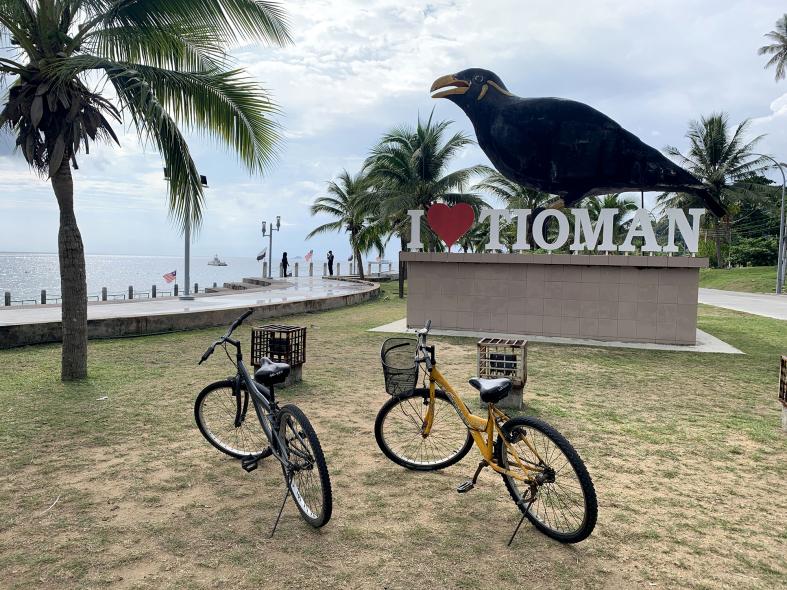
The paved road along Tioman’s west coast that runs through Tekek and Air Batang is ideal for a cycling jaunt, with lovely sea views.
I start my journey from Tekek South Bay near the jetty and head north. A giant statue of a mynah bird greets me as I pass through the Esplanade area.
As I enter Air Batang, the bustle of Tekek’s activity falls away and the road narrows to a single pathway, wide enough for just one cyclist.
Beyond Air Batang Jetty, it ends abruptly at a cliff face where the only way forward involves a steep stair climb and intensive jungle trek. Make your way back to Tekek from here. The round-trip journey is about 9km and takes two hours, with plenty of photo stops.
Late afternoon is a good time for cycling and, on a clear day, you might catch a brilliant sunset between 6 and 7pm. I rent my bicycle from Cheers Chalet and Souvenir in Tekek, where there are several other shops offering bicycle and motorcycle rental. Bicycles cost RM5 an hour and RM15 to RM25 a day, while motorcycle rental starts at RM20 an hour.
Traffic in Tekek mostly consists of occasional cars and minivans transporting resort guests around, and locals and tourists zipping about on two wheels, many without helmets. Go slowly and take care.
Jungle trekking between villages
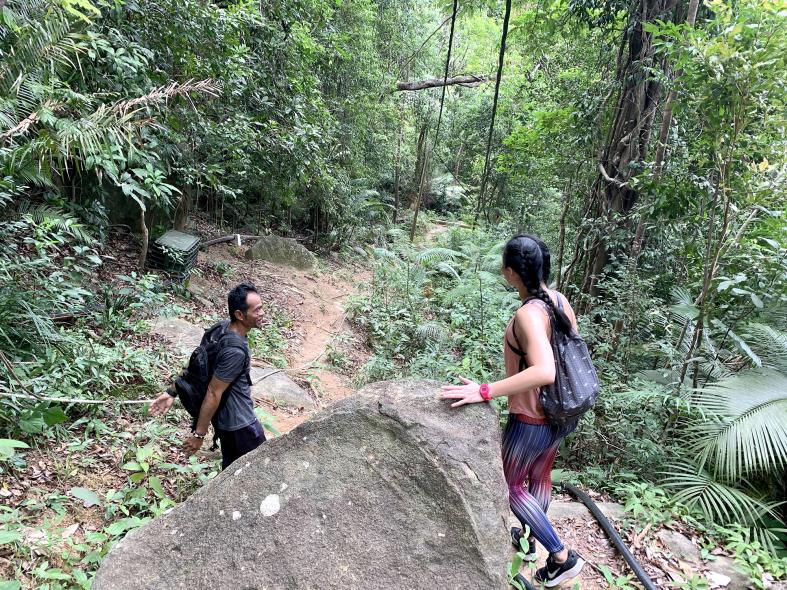
There are forest paths to get between Tioman’s villages on foot, and several popular treks to explore the island’s lush tropical greenery.
In Paya, an easy 30-minute hike leads you through the foliage to a massive fig tree with a twisted network of roots completely engulfing the giant boulder it is growing on. Known as Mother Willow, the locals estimate this tree to be about 300 years old.
It stands at an impressive 10m high, though this feels much higher when I am gripping on for dear life at the top of the ladder built into the side of the rock, with nothing securing me but my hands and feet.

Along the way, stop for a break at the Rock Falls, a mini waterfall and swimming hole along a river that flows through the forest. It had not rained the day before and is just a rock pool when I visit, but it is nice to soak my feet and cool off in the humid jungle.
Another well-trodden path crosses the island from Tekek to Juara. What normally takes about 30 minutes on a four-by-four vehicle is about a three-hour hike through the forest, where you will pass local landmark Ali’s Waterfall and, if you are lucky, spot the large, endangered Rafflesia flowers that smell like rot when they bloom.
Spot turtles and flying foxes

Green sea turtles and hawksbill turtles sometimes find their way onto Tioman’s sandy shores to lay their eggs in the nesting season between March and October. That is when the Juara Turtle Project (juaraturtleproject.com) volunteers step in to protect and care for these eggs in their hatchery, which you can visit at Mentawak beach in Juara.
The dense tropical forests are home to a variety of snakes, monitor lizards and birds, as well as some endangered species like the binturong, brush-tailed porcupine and the larger mousedeer.
Look up at the trees next to Tekek’s public beach in the late afternoon and you might spot hundreds of flying foxes with bright orange bellies and brown wings huddled upside down on the tree branches.
Chill in a resort
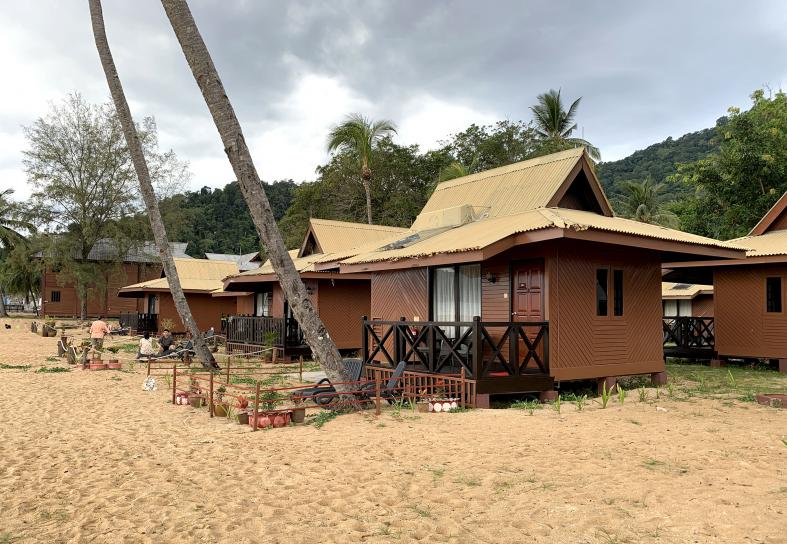
Tioman is not what one might associate with luxury, but my stay at the Berjaya Tioman Resort checks all the getaway boxes.
The chalets and rooms of this four-star hotel are modelled after traditional Malay houses raised on stilts with sloping roofs and wooden walls. I enjoy a comfortable stay in a Garden Premier Terrace Room, one of the more spacious rooms with an indoor sitting area and outdoor terrace.
Room rates range from RM750 to RM1,600 a night. Top up RM500 a night for a full-board package that covers all meals and drinks at the in-house restaurant.
The resort, Tioman’s largest, includes an 18-hole golf course on its grounds, which offers spectacular sea views while you putt. For divers, its dive centre is located right in front of the famous Renggis Island where turtle and shark sightings are frequent.
There are bicycles and all-terrain vehicles to rent, tennis and basketball courts, and a large recreation centre and spa in case you need to wait out some sudden tropical downpours. And if all you want is peace and quiet, stroll down its long stretch of private beach to catch a brilliant sunset.
Tioman travel tips
The best time to visit Tioman is between March and October, when the weather is sunny and dry. From November to February, the rainy monsoon season is great for pro surfers who usually head to Juara to catch some epic waves, but not so much for a beach holiday or anyone on a boat.
Large resorts usually have their own in-house dining, though you can usually find cheaper local fare in zi char-style eateries or kopitiams in the villages, with the occasional spot for tourists craving cafe food such as waffles or burgers.
Pick up groceries, snacks and drinks from minimarts, as well as plastic bottles of petrol to top up motorcycle tanks as there are no petrol kiosks on the island.
Hiking shoes are recommended as the terrain is hilly and forested. Pile on the insect repellent as mosquitoes here are huge and can bite through thin clothing. Avoid ant nests and snakes in the undergrowth, and be prepared for leeches if it has been raining.
While the beaches are beautiful, beware of sandflies. Buy sandfly repellent or make some for yourself – the Berjaya Tioman Resort has spray bottles of diluted dettol mixed with curry leaves along their beaches that work quite well.
The most common way to get to Tioman is to travel by road from Singapore to Mersing, then take a ferry from Mersing to Tioman.
Round-trip bus transfers (kkkl.com.sg or busonlineticket.com) cost about $80 a person, while hiring a private car costs about $440 (sgmytaxi.com). It takes about three to six hours to get to Mersing, depending on traffic at customs. Plan for more time if you are travelling during weekends and public or school holidays.
Ferries take two to three hours, depending on where in Tioman you alight. It costs RM80 to RM300 – prices vary due to promotions and your class of seats. For more information, go to cataferry.com or bluewater.my
- The writer was hosted by Berjaya Tioman Resort.
- Jaclynn Seah is The Occasional Traveller (theoccasionaltraveller.com), a freelance travel writer and blogger juggling a full-time job with perpetual wanderlust.
- Weekend Trip is a series that looks at regional destinations through fresh eyes. For more travel stories, go to str.sg/travel.
Get The New Paper on your phone with the free TNP app. Download from the Apple App Store or Google Play Store now

